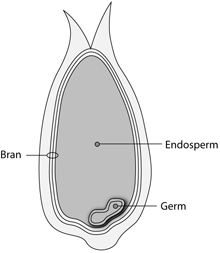Lesson 7: Grains, Pasta, Soups, and SpicesObjective 1
The Grains Group of the MyPyramid allows for the most servings per day. Foods from this group are vital to good health. In the U.S., the most commonly consumed grains are wheat, corn, rice, oats, rye, barley, and millet. Grain products contribute complex carbohydrates, protein, vitamins and minerals to your diet. In addition, whole grains also provide fiber, which aids in digestion and elimination. The proteins in cereal grains are low in nutritional value. However, grains can be combined with other foods that can complement and complete the incomplete protein in the grain product. For example, the protein in peanut butter complements and completes the protein in a slice of bread, and the protein in dry red beans compliments and completes the protein in rice. There are many such food combinations that can help you obtain the nutrients you need while saving you money. Such food combinations are especially common in third-world countries. The nutritional value of a grain depends on how it is processed. All grains are composed of three parts—the bran, the endosperm, and the germ. 
Structure of grain
The bran, or outer layer of the grain, provides a protective coat and is rich in fiber. The bran is usually removed for white flour, white rice, etc. The endosperm, which is the bulk of the grain, provides food for the new plant as it develops from the kernel. It contains most of the protein and starch of the kernel. The germ is a small structure at the bottom of a kernel. It is rich in fat, protein and vitamins. If the food indicates “whole grain,” it is processed with just that—all three parts of the kernel-and thus provides the most nutrients and dietary benefits. If a product indicates “enriched,” it has been made from the endosperm, to which nutrients have been added. The nutrients added are the same ones that were lost by removing the bran and germ, but the amounts may vary. When missing nutrients are added to white rice, it is called converted rice. MyPyramid makes grain recommendations in ounces. Equivalents of one ounce portions would be one slice of bread, half an English muffin, half a hamburger bun, an ounce of ready-to-eat cereal, half a cup of cooked pasta, half a cup of cooked rice, half a cup of cooked cereal, one tortilla, one roll, or one muffin. One half of grains eaten should be whole grains. At this point, let me introduce you to a very valuable resource in your community—your Extension Agent. Each state in the U.S. has a Land Grant College, usually a state university that supports County Extension Services. In Utah, for example, Utah State University in Logan, Utah, supports the County Extension Program, listed in most telephone directories under “Utah State University Extension Services.” When you call any extension office, you can speak with a home economist who can find answers to questions that you may have about cooking, as well as other matters of the home—clothing construction, home décor, child care, etc. The extension service also has the world’s best collection of recipes. Remember that when it comes to getting answers to questions about home and family, the extension home economist can be your best friend. If you cannot locate your nearest extension office in a phonebook, you should be able to find them through an internet search, using your state and "extension service" as key search words. Reading AssignmentBetty Crocker's Cookbook:
|
About Us | Terms of Use | Contact Us | Partner with Us | Press Release | Sitemap | Disclaimer | Privacy Policy
©1999-2011 OpenLearningWorld . com - All Rights Reserved